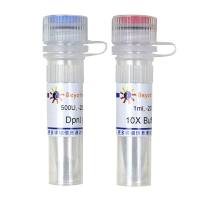DpnI mediated site-directed Mutagenesis
互联网
1. DNA
DNA template plasmid 5-20 ng
10x pfu DNA polymerase buffer 5.0 µl
25uM oligo 1 0.5 µl
25uM oligo 2 0.5 µl
10mM dNTP 1.0 µl
Pfu DNA polymerase (2.5 units) 1.0 µl
fill w/ddH2O to 50 µl
2. PCR conditions
95°C 30 seconds,
18 cycles of : 95°C 30 seconds,
55°C 1 minute,
68°C 2 minutes/kb of plasmid length
3. Degradation of methylated (parental) DNA with DpnI
Cool down PCR reaction.
Add 1µl Dpn I (10 unit) to PCR reaction 37°C and incubate for 1 hr.
4. Transformation into E. coli
Place 200 µl highly competent cells (1 x 108/ug efficiency or greater) DH5 a on ice.
Add 1-2 µl of digested PCR reaction.
Incubate on ice 15-20 minutes.
Heat shock 60-90 seconds, and return to ice for 2 minutes.
Add 1 ml LB broth. Incubate at 37°C for 1 hr.
Plate 100 µl aliquot on appropriate antibiotic plate.
5. Miniprep 6 colonies and digest plasmids looking for mutant.
6. Sequence the lesion to confirm the change.
Notes:
Design of oligos
Oligos should be perfectly complementary (actually haven't checked out if this in required). The oligos should contain 12-15 bp on each site of the lesion. It is useful to engineer a restriction site addition or loss into the oligos for ease of screening. We have used the protocol for deletions using 17 bp on each side of the deletion.
Plasmid size
We have used the protocol for plasmids over 18 kb in length. Plasmids below 10 kb seem to work routinely. In most cases, a vast majority 80-100% of colonies are correct. For longer plasmids it may be necessary to work with PCR to optimize synthesis.
Introduction of lesions
Note that this is a linear amplification, so that the template only gets copied one time. Hence the odds of introducing lesions when using a high fidelity polymerase are very low.
Analysis of PCR product by gel electrophoresis
Run an agarose gel ( 5 -10 µl). If the product is visible, the mutagenesis will almost certainly work. Even if the product is not visible, one often get the mutant.
Using other polymerases
We have started using TaKaRa Ex taq instead of pfu polymersase with great success using large plasmids (15-20 kb size). While getting the amplification to work efficiently with pfu take a bit of fiddling, amplification with Ex taq appears very robust for large plasmids.
REFERENCES
Fisher, C. L., and Pei, G. K. (1997). Modification of a PCR -based site-directed mutagenesis method. Biotechniques 23 , 570-574.







